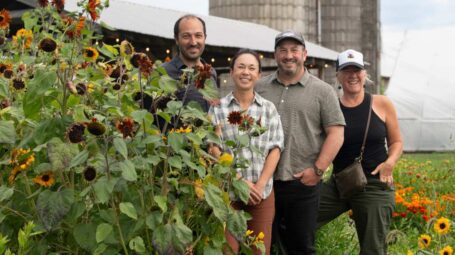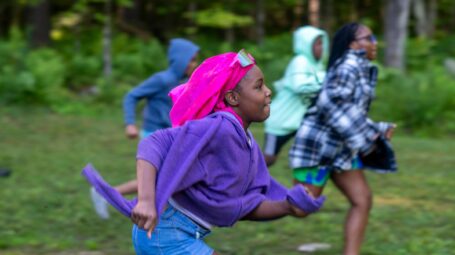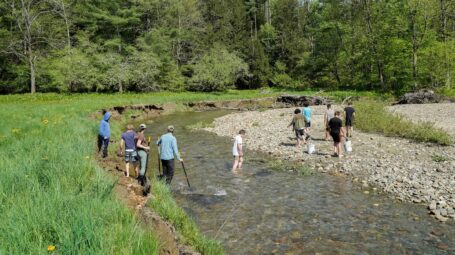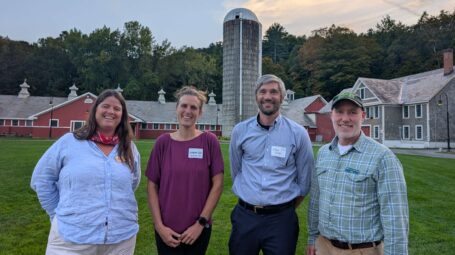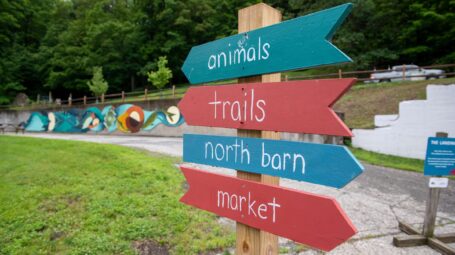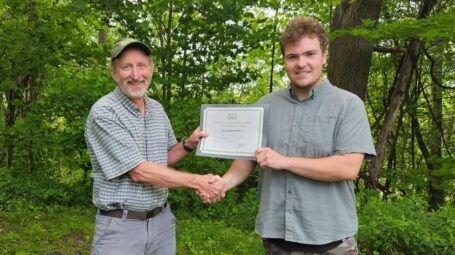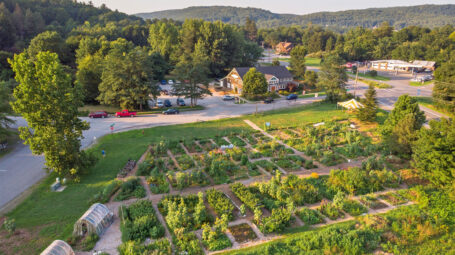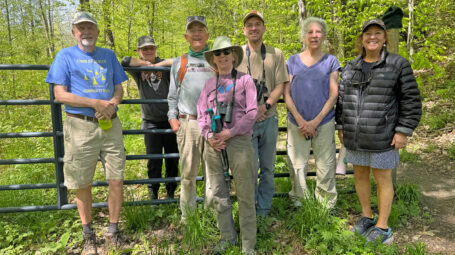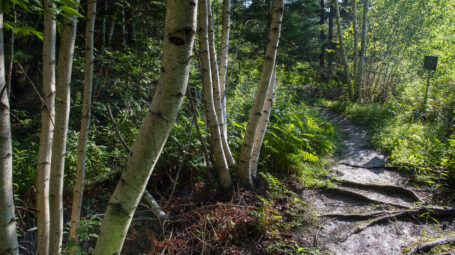Monkton secures 450 acres for wildlife habitat, recreation, and forest health after successful campaign to raise over $1.1 million
The Town of Monkton bought 450 acres to establish their new town forest and conserved the land with the Vermont Land Trust, the two entities announced today. The Town purchased the land from the A. Johnson Company, a local forestry and timber management company that operated a sawmill in neighboring Bristol for almost a century.
Stephen Pilcher, Selectboard Chair for Monkton, said: “As Monkton continues to grow, it is more important than ever to protect our forests, preserve our wetlands, and create and maintain recreational opportunities. The Monkton Town Forest will accomplish these goals and be a bridge between Monkton’s past and future.”
The new town forest is located at the southern end of Monkton, along the Bristol town line. It abuts 1,000 acres of conserved forest at Bristol’s Watershed Center and is part of a nearly 2,500-acre block of contiguous forestland and wildlife habitat that has been identified as high priority interior forest at a state level. It joins hundreds of other forests owned by Vermont municipalities, including over 12,000 acres of forestland conserved with VLT.
The property has significant opportunities for outdoor recreation, including areas with gentle terrain near access points, ponds, extensive forestland and existing woods roads that were used informally in the past by the community.
Through a multi-year campaign, the Town and VLT raised over $1.1 million to buy and conserve the property and establish a management fund to help care for the land and improve public access for recreation and education.
“This has been a really impressive community-driven effort,” said Bob Heiser, Project Director for VLT. “Local community members and volunteers were very intentional and generous in their search for land that could deliver the broad sweep of natural and community benefits they were seeking in a town forest. We’re honored to help create this latest addition to Vermont’s community spaces.”
Wildlife habitat, streams and wetlands protected
The diverse property has five vernal pools, extensive beaver-influenced wetlands, multiple ponds and miles of streams, including headwater tributaries of Pond Brook and Little Otter Creek. There are special natural areas, including a red maple-black ash seepage swamp, a dry oak-hickory-hophornbeam forest and habitats for rare and endangered species.
History of the new Monkton Town Forest
The A. Johnson Co. acquired the diverse forestland parcel on the Bristol town line in 1975, prior to which it was used to mine iron ore in the early 1800s and later to extract kaolin, a naturally occurring clay with many industrial and medical uses. During A. Johnson Co.’s ownership, the land was managed primarily for timber and harvested wood was processed in their Bristol mill.
The new community resource is the result of over ten years of planning, effort and collaboration. Since 2014, the Monkton Town Plan has included a goal of exploring the creation of a town forest. In 2019, the Monkton Selectboard formed a Town Forest Committee to explore the possibility. The committee researched town forests, sought community input, and considered potential parcels in town.
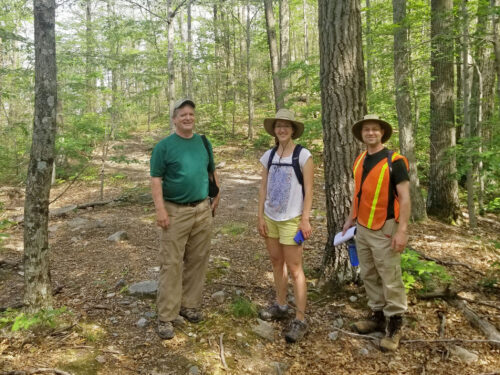
Left to right: John McNerney, Callie Brynn, and Jaime Schulte of the Monkton Town Forest Committee during a site visit to the new Monkton Town Forest.
In early 2022, the committee approached the A. Johnson Co. about buying this parcel. The A. Johnson Co. worked in close partnership with the Town and VLT over the ensuing years to make the purchase happen.
In a statement from A. Johnson Co. LLC, Ken Johnson and Bill Sayre said: “This property has a fascinating history in parallel with the history of Vermont. From this land came iron ore for Commander Thomas Macdonough’s fleet, which defeated the British Royal Navy in the Battle of Lake Champlain during the War of 1812. It then became a diverse collection of small sheep and crop farms to feed and clothe our communities, then a source of raw material for Bostwick’s Kaolin Clay experiment, and most recently as working forest, supplying quality hardwoods for beautiful furniture and flooring, enjoyed by families throughout America and the world. We are pleased to know that the people of Monkton, with the help of the Vermont Land Trust and other conservation leaders, will continue this long tradition of managing the land as part of Vermont’s working landscape.”
The effort was funded by grants from the Vermont Housing & Conservation Board (VHCB), the USDA Forest Service Community Forest and Open Space Program, existing Town funds (American Rescue Plan Act funds and the Agricultural and Natural Area Fund), Davis Conservation Foundation, NorthCountry Federal Credit Union, and numerous generous community members and additional grants.
“Multi-faceted conservation projects like this provide so many benefits to Vermont,” said VHCB Executive Director Gus Seelig. “Our Board congratulates VLT and the Town of Monkton on this remarkable accomplishment and thanks A Johnson Co. for their dedication to see it through. As a result, this new town forest will protect biodiversity and the health of important natural areas while enhancing quality of life by providing a variety of outdoor recreation and education opportunities for Vermonters. The parcel’s proximity to the previously conserved Bristol Watershed moves Vermont closer to the goals established in Act 59, which seeks permanent protection for 30% of Vermont.”
On November 22, 2024 the Town of Monkton bought the property and conserved it. The conservation easement permanently protects the land as a town forest and secures the public’s access to it. Management decisions will be decided by the community within the terms of the easement through the development of a management plan.
Through the local fundraising effort, a Town Forest Management Fund was created to help with costs such as access improvements, parking, trails, signage, wildlife habitat enhancement, and to leverage competitive grant funding. The town has an Interim Management Plan in place for four to six months that will be replaced by the long-term management plan the community is actively working on.
“We are grateful to everyone that has helped make the Town Forest a reality and look forward to a community celebration in the Spring of 2025,” said Callie Brynn, Chair of the Town Forest Committee.
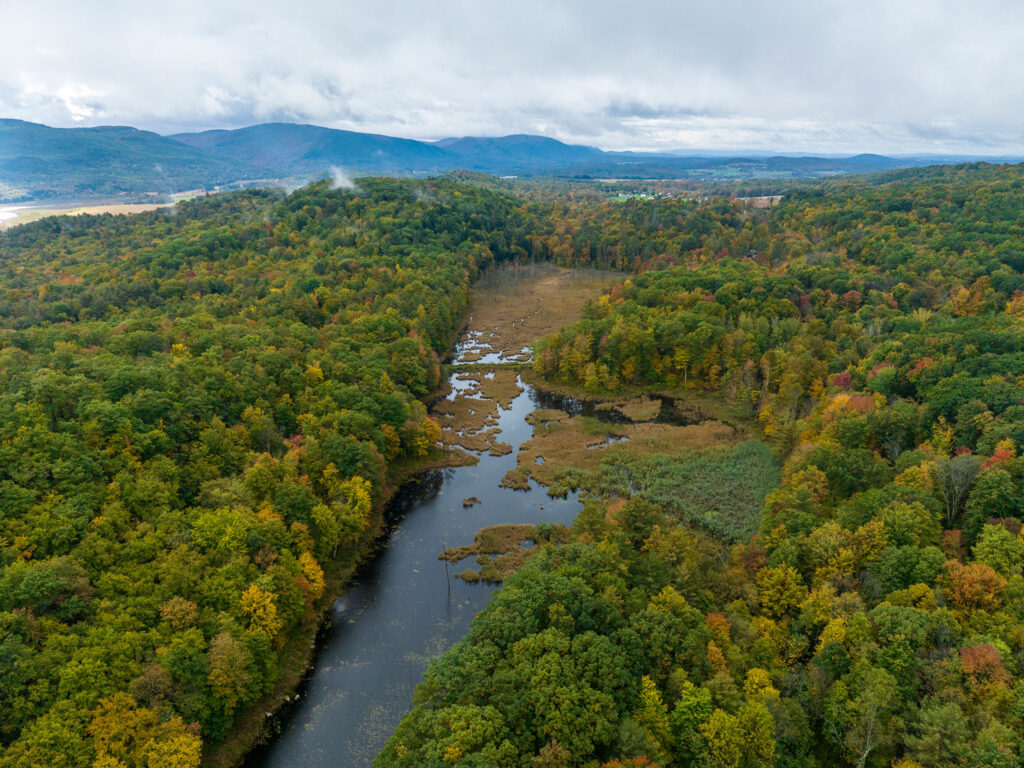
The new Monkton Town Forest in the foreground; looking south to Bristol beyond.

